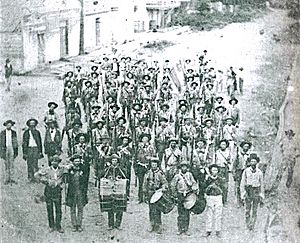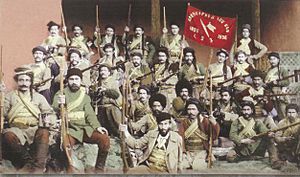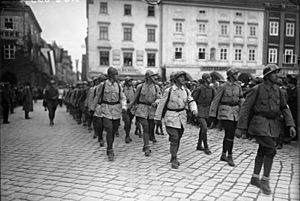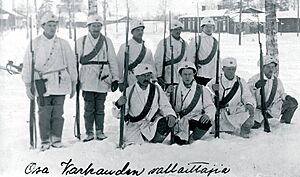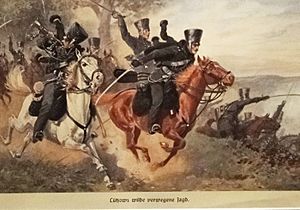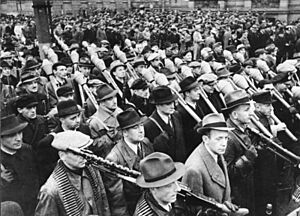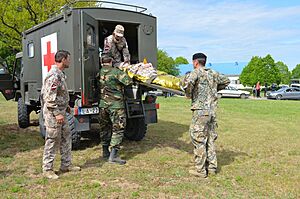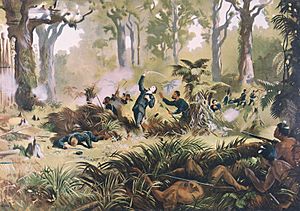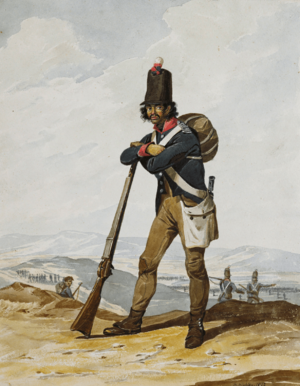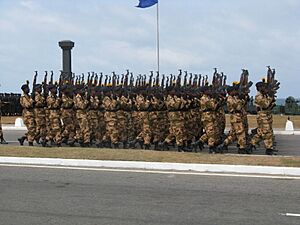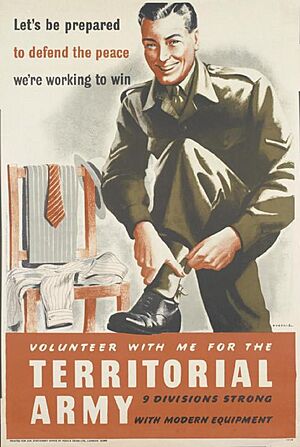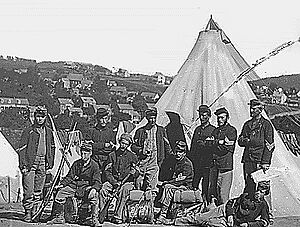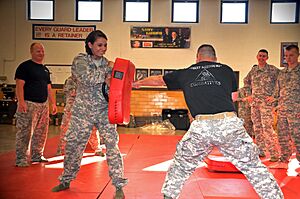Militia facts for kids
A militia is a group of people who are not full-time soldiers but can be called upon to serve in the military when needed. Think of them as citizens who are ready to defend their community or country, especially during emergencies. Unlike professional armies, militias often serve part-time and might only operate in their local area. They usually help regular troops by scouting, defending forts, or fighting in small, quick battles, rather than leading big attacks on their own.
Sometimes, modern militias, like the United States National Guard, are trained to the same high standards as full-time soldiers. This means they are very skilled, even if they are only "on-call" or part-time.
Militias can be different things depending on the situation:
- They can be groups that protect a community, its land, property, and laws.
- They might include all healthy adults in a town or state who can be called to arms.
- Some militias are private groups not directly supported by the government.
- In some countries, like Russia, the term "militsiya" used to refer to the regular police force.
- There are also "maritime militias" made up of fishermen who help a country protect its ocean borders.
Contents
- What Does "Militia" Mean?
- Militias Around the World
- Afghanistan
- Andorra
- Argentina
- Armenia
- Australia
- Austria
- Bahrain
- Belgium
- Brazil
- Canada
- China
- Cuba
- Denmark
- Estonia
- Ethiopia
- Finland
- France
- Germany
- India
- Iran
- Iraq
- Israel
- Latvia
- Libya
- Mexico
- Montenegro
- Netherlands
- New Zealand
- North Korea
- Norway
- Pakistan
- Portugal
- Russia and the Soviet Union
- Sri Lanka
- Sudan
- Sweden
- Switzerland
- Syria
- Turkey
- United Kingdom
- United States
- Texas
- Vietnam
- SFR Yugoslavia
- See also
What Does "Militia" Mean?
The word militia comes from old Latin words:
- miles: meaning soldier
- -itia: meaning a state or condition of being
So, militia means "military service." The word has been used since at least the 1590s to describe a military force or a group of soldiers.
Militias Around the World
Afghanistan
Militias have played a big part in Afghanistan's history. They have helped shape the country and its military actions over time.
Andorra
Andorra has a very small army, which is mostly for ceremonial duties today. Historically, all able-bodied men could be called to fight if needed. This system was called the Sometent. The army hasn't fought in over 700 years, and its main job is to carry the Andorran flag at official events.
Argentina
In the early 1800s, when Buenos Aires was attacked by the British, regular soldiers weren't enough. So, all men who could fight were called into militias, including people who were usually lower in society. These militias helped defeat the British. Later, they became important in local politics and helped start the Argentine War of Independence.
Armenia
Armenian militias, also known as fedayi, were very important in helping different Armenian states gain independence. They also played a role in the Georgia-Abkhazia War in the early 1990s.
Australia
Australia had a "Volunteer Defence Corps" (VDC) during World War II, similar to the British Home Guard. It was formed by citizens worried about a possible Japanese invasion. Members learned about guerrilla warfare. The government later supported and equipped them, but the VDC was disbanded after the war when the threat was gone.
Austria
After World War I, many militias formed in Austria, especially when soldiers returned home to find their villages occupied. These groups, like the Volkswehr (People's Defense Force), fought against occupying forces. Later, during the First Austrian Republic, political parties formed their own militias, which sometimes led to violence. Today, Austria has a militia as part of its armed forces, similar to the US National Guard.
Bahrain
In Bahrain, a small militia group called Katibat al Haydariyah appeared in 2015. This group has claimed responsibility for attacks against the Bahraini government.
Belgium
The Garde Civique (Civic Guard) was a Belgian militia that existed from 1830 to 1920. It was formed to protect property and keep order after the Belgian Revolution. It was disbanded after World War I.
Brazil
In Brazil, the word milícia is often linked to unofficial armed groups and criminal organizations.
Canada

In Canada, "Militia" used to mean the land forces, both full-time and reserve. The first Canadian militias started in the French colonial period. Settlers were required to join to help defend the colony. After the British took over, local militias supported British soldiers. These units were usually only active during wartime.
In 1855, the Militia Act created the Active Militia, which included a full-time professional army and a reserve force. After most British soldiers left Canada in 1871, the Canadian militia became the main land force. Today, the Canadian Army Reserve is still sometimes called the militia, and its members train part-time and can volunteer for overseas missions.
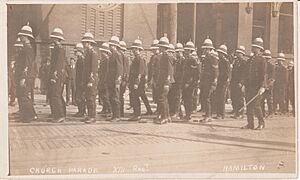
China
China's current militia is led by the Chinese Communist Party and is part of the country's armed forces. They help with war preparations, security, and keeping public order. Historically, Chinese villages and clans also had their own militias, especially during times of trouble or attacks by pirates.
Cuba
Cuba has three militia groups: the Territorial Troops Militia (about one million people, half women), the Youth Labor Army (focused on farming), and a naval militia.
Denmark
The Danish Home Guard is a branch of the Danish military. It used to only defend Danish territory but now also helps with international military efforts. It has five parts: Army, Naval, Air Force, Police, and Infrastructure Home Guard.
Estonia
The Omakaitse (Home Guard) was a group formed by local people in Estonia during World War II. It was based on earlier defense groups and resistance movements.
Ethiopia
The People's Militia was created in Ethiopia in 1975 to help the police and protect farms. Another group, the Fano militia, is an ethnic militia that has been involved in recent conflicts and accused of serious harm against other groups.
Finland
Finland uses conscription, meaning many citizens serve in the military. While they don't have separate militia units, all units are part of the Finnish Defence Forces. Historically, before Finland became independent, there were White Guards (non-socialists) and Red Guards (socialists) who fought in the Finnish Civil War.
France
Early French militias include the Gauls who resisted the Romans, and the group led by Joan of Arc. During the French Revolution, the National Guard was a home defense militia. In World War II, the French Resistance fought against German forces, while the French Militia supported the German-controlled government. The French National Guard was reestablished in 2016 for homeland security.
Germany
Early German militias were similar to the Anglo-Saxon fyrd. The term Freikorps (Free Corps) first meant volunteer armies. During the Napoleonic Wars, these groups fought against French occupiers. After World War I, Freikorps became nationalist groups, often involved in political violence. The Nazi Party also created its own paramilitary groups, like the Sturmabteilung (SA) and Schutzstaffel (SS), which were very powerful. Near the end of World War II, the Volkssturm was a national militia made of older men, women, and children, used to help the army.
India
The Salwa Judum was a militia active in the Chhattisgarh state of India. Village Defence Guards (VDGs) were set up in Jammu and Kashmir to help villagers protect themselves from threats. These groups are made of volunteers, some of whom are paid.
Iran
The Basij militia, founded in 1979, is a large group of men (up to 300,000 active and reserve members) that supports the Islamic Revolutionary Guard Corps in Iran.
Iraq
Since 2014, when ISIL rose, Shiite militias in Iraq have become very important. They have joined the Iraqi Army in many big battles against ISIL.
Israel
In 1908, a Jewish group called Hashomer became an armed militia to protect Jewish settlements in Ottoman Palestine. Today, the Israel Defense Forces (IDF) is often seen as a militia because it relies heavily on citizens serving in reserve duty, rather than only full-time soldiers.
Latvia
The Latvian National Guard was created in 1991 as a volunteer military self-defense force.
Libya
After the fall of Gaddafi's rule in Libya, rebel groups that helped in the revolution split into self-organized militias. These groups have been involved in conflicts over control of cities, and reports of violence by them have increased.
Mexico
Mexico has a long history of militias and armed groups. In the 1600s and 1700s, "Free-Colored Militias" were important in Colonial Mexico. These groups were made up of people of mixed heritage and helped defend Spanish territories. They were organized into units with officers and soldiers, and some received pay. While the government now sees unofficial militias as illegal, there have been recent cases where civilian self-defense groups appeared during the Mexican war on drugs. The government sometimes tries to regulate these groups or combat them if they resist.
Montenegro
In 1910, the King of Montenegro declared that all male citizens were part of a national militia and had to own a certain type of revolver. This was meant to deter other countries from attacking Montenegro, but it was also believed the King might have benefited financially from it. The revolver became a symbol of status for Montenegrin men.
Netherlands
The Schutterij was a volunteer city guard or citizen militia in the medieval and early modern Netherlands. Their job was to protect towns from attacks and act during revolts or fires. Today, it's a title for ceremonial shooting clubs and the country's Olympic rifle team.
New Zealand
From 1840, British troops were the only military in New Zealand. But after a war in 1845, a Militia Act was passed, making militia service compulsory. Many local militias fought alongside British troops in the New Zealand Wars. Later, these units became the Territorial Army in 1911.
North Korea
The Worker-Peasant Red Guards is a North Korean paramilitary group organized at local levels (province, town, city, village).
Norway
The Norwegian Home Guard is a military force that helps protect the country.
Pakistan
Militias have been very important in supporting Pakistan's military, especially since the 1947 war when they helped gain control of parts of Kashmir. They also helped in later wars. Today, Pakistani citizens forming militias in the Khyber Pakhtunkhwa province are involved in the "war on terror."
Portugal
Portugal has a long history of using militias for defense. From the 12th to 16th centuries, municipal militias were the main part of the Portuguese Royal Army. Later, the Ordenanças were created as a national army base and local defense force. During the Peninsular War, militias played a key role in defending the country against Napoleon's army. In the 20th century, there were some new militia-like forces, including the Portuguese Legion, which focused on civil defense during the Cold War.
Russia and the Soviet Union
Neither the Russian Empire nor the Soviet Union had a regular militia. Instead, during emergencies, they used a system called Narodnoe Opolcheniye (People's Regimentation). These were voluntary groups of local people who helped the regular army. The term Militsiya in Russia and former Communist countries referred specifically to the civilian police force, not a military militia.
Sri Lanka
Sri Lankan Kings used to raise militia armies for their military campaigns, as they didn't have a standing army. Colonial powers like the Portuguese and Dutch also used local militias. Later, the British formed regular units of Sinhalese people. During the Sri Lankan Civil War, local villagers formed militias to protect their homes, which later became the Sri Lanka Civil Security Force.
Sudan
The Janjaweed militia is made up of armed Arab Muslims who fight for the government in Khartoum against non-Arab Muslim groups. They are active in the Darfur region and have been accused of serious human rights abuses.
Sweden
As of 2012, the Swedish Home Guard has 22,000 members organized into battalions. Their main job is to guard important military and civilian places across the country. Many members are in "Rapid Response units" which are motorized and ready to be called up quickly.
Switzerland
One of the oldest and most famous militias is the Swiss Armed Forces. Switzerland has a large military force for its size, based on the "militia principle." This means that most adult men (and some women volunteers) are part of the military. They often keep an assault rifle at home and regularly train in combat and marksmanship. This system is central to Swiss culture, even for things like the fire department.
Syria
The Syrian National Defense Force was formed from pro-government militias. They get their pay and equipment from the government and fight against rebels on the ground, working with the army.
Turkey
The Kuvayi Milliye were local militia forces that played a role in the Turkish War of Independence.
United Kingdom
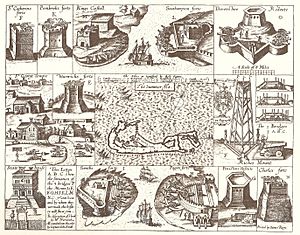
In England, the idea of a militia goes back to Anglo-Saxon times, where all healthy men could be called to serve. This developed into the militia, which was organized by county. In the 16th and 17th centuries, the militia became more important, with trained bands forming in cities like London.
As the British Empire grew, militias were also formed in colonies like Jamestown, Virginia, and Bermuda, where they helped defend against attacks.
Political Issues
After the Glorious Revolution in 1688, many in England didn't trust a large standing army. They preferred a small army for defense and a militia of local citizens to keep order and protect freedoms. The English Bill of Rights (1689) stated that a standing army in peacetime needed Parliament's approval and that Protestants could have arms for defense, implying they could serve in the militia.
18th and 19th Centuries
The Militia Act of 1757 made the militia more professional. Men were chosen by ballot to serve longer, received uniforms and better weapons, and trained regularly. During the French and Napoleonic Wars, the militia served in important locations, like the South Coast and Ireland. They also helped train new soldiers for the regular army.
In the 19th century, the militia became a volunteer force. Men would volunteer for basic training and then return to civilian life, reporting for regular training and an annual camp. This was popular with people in casual jobs, as it offered extra pay.
Modern Times
The militia was changed into the Special Reserve in 1907. These units trained soldiers and supplied replacements for overseas units during World War I. The name "militiamen" was briefly used again in 1939 for conscripted men, but full-time conscription soon took over.
Today, three units in the British Army still use the "militia" name: the Royal Monmouthshire Royal Engineers, the Jersey Field Squadron, and the Royal Alderney Militia. The Atholl Highlanders are also a unique ceremonial infantry militia, the only legal private army in Europe.
United States
The history of militias in the United States goes back to colonial times. Like the English system, colonial militias were made up of adult male citizens. They were very important in local conflicts, especially during the French and Indian Wars. Before the American Revolutionary War, American revolutionaries took control of the militia system. They also created a full-time army, the Continental Army, but militias provided important support throughout the war.
Militia service was different from regular military service because it was usually for short periods to meet a threat, not a fixed long-term commitment. Militia members often provided their own weapons.
After the US Constitution was written in 1787, the federal government and the states shared control over the militia. The Militia Act of 1792 said that most free, healthy white male citizens aged 18-45 had to enroll in the militia and provide their own weapons.
19th Century
In the 1800s, American militias fought in various conflicts, including the War of 1812 and the American Civil War. Sometimes, militias were not well-prepared. After the Civil War, some secret groups and private militias formed in the South. These groups used force and intimidation to affect politics and suppress the rights of formerly enslaved people.
20th Century
The Militia Act of 1903 divided the militia into the "organized" militia (which became the state National Guard units) and the "unorganized" militia (all other males aged 17-45). The National Guard has a "dual enlistment" system, meaning its members are also part of the US Army or Air Force reserves. The 20th century also saw the rise of private militia groups in the US, some with anti-government views.
21st Century
In 2008, the Supreme Court discussed the definition of "militia" in the US. It noted that in colonial times, "militia" included both federally organized groups and citizen-organized groups. Today, the National Guard and state defense forces are active militias in the US.
Texas
The Texas Militia played a big role in the Texas Revolution in 1836, helping Texas gain independence from Mexico. After the war, some militia units became the famous Texas Rangers. Texas militias also fought in the Mexican-American War and the American Civil War. Today, Texas maintains a recognized State Militia called the Texas State Guard.
Vietnam
The Dân quân tự vệ (Self-Defence Militia) is part of Vietnam's armed forces. It is organized at the local level and helps with defense and other tasks.
SFR Yugoslavia
Besides the main Yugoslav People's Army, each republic in former Yugoslavia had its own Territorial Defense Forces. These forces were like military reserves or militias, designed to help defend the country in a total war scenario.
See also
 In Spanish: Milicia para niños
In Spanish: Milicia para niños


